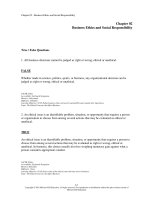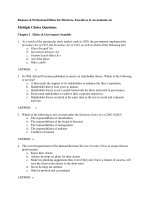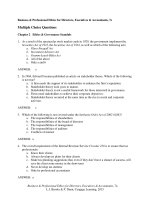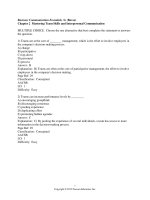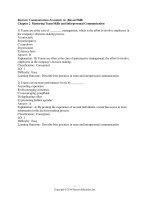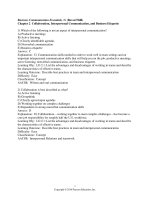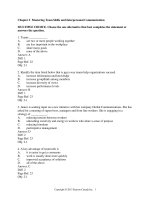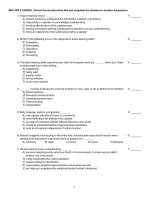Business communication essentials third canadian edition 3rd edition bovee test bank
Bạn đang xem bản rút gọn của tài liệu. Xem và tải ngay bản đầy đủ của tài liệu tại đây (278.39 KB, 29 trang )
Chapter 2 Mastering Team Skills and Interpersonal Communication
MULTIPLE CHOICE. Choose the one alternative that best completes the statement or
answers the question.
1. Teams ____________.
A.
are two or more people working together
B.
are less important in the workplace
C.
share many goals
D.
none of the above
Answer: A
Diff: 1
Page Ref: 22
Obj: 2-1
2. Identify the item listed below that is not a way teams help organizations succeed.
A.
increase information and knowledge
B.
increase groupthink among members
C.
increase diversity of views
D.
increase performance levels
Answer: B
Diff: 1
Page Ref: 23
Obj: 2-1
3. Janice is seeking input on a new initiative with her company Global Communications. She has
asked for a meeting of supervisors, managers and front line workers. She is engaging in a
strategy of ___________.
A.
reducing tension between workers
B.
unleashing creativity and energy in workers who share a sense of purpose
C.
reducing boredom
D.
participative management
Answer: D
Diff: 2
Page Ref: 23
Obj: 2-1
4. A key advantage of teamwork is
A.
it is easier to get a consensus
B.
work is usually done more quickly
C.
improved acceptance of solutions
D.
all of the above
Answer: C
Diff: 2
Page Ref: 23
Obj: 2-1
Copyright © 2013 Pearson Canada Inc. 1
5. Teams tend to be ineffective when there is/are ____________.
A.
few members
B.
only one focus
C.
high involvement
D.
a lack of trust
Answer: D
Diff: 2
Page Ref: 23
Obj: 2-1
6. When peer pressure in a team is more important to members than making the right decision,
that team may develop what is termed ____________.
A.
increased performance levels
B.
groupthink
C.
effective team work
D.
diversity of views
Answer: B
Diff: 2
Page Ref: 23
Obj: 2-1
7. Hidden agendas occur in teams when team members ____________.
A.
read one another’s nonverbal messages
B.
don’t contribute their fair share
C.
place greater value on belonging to a team than making right decisions
D.
have private motives that affect the group’s interaction
Answer: D
Diff: 1
Page Ref: 23
Obj: 2-1
8. Team conflict may be good if it ____________.
A.
forces important issues into the open
B.
allows weak employees to contribute
C.
gets every employee to think alike
D.
creates a tighter organization
Answer: A
Diff: 2
Page Ref: 23
Obj: 2-1
Copyright © 2013 Pearson Canada Inc. 2
9. Effective teams do all of the following except ____________.
A.
have a clear sense of purpose
B.
think creatively
C.
reach decisions by consensus
D.
consider every possible perspective
Answer: D
Diff: 2
Page Ref: 23
Obj: 2-1
10. When undertaking a collaborative writing project, which of the following steps is best
undertaken by individual team members rather than by the team working as a group?
A.
outlining the project and determining project goals
B.
planning
C. writing
D.
research
Answer: C
Page Ref: 24
Difficulty: 2
Obj: 2-1
11.
TGA Solutions has employees in branches across Canada. The company wants to create a
common site for information about all the projects that its employees tackle, the solutions they
offer, and the outcomes of these solutions over time. Most of its employees are not well versed
with creating web content, but will be required to update the site frequently by themselves,
adding their observations and experiences. Which of the following technologies is the best option
for both TGA and its employees?
A.
a centrally-controlled content management system
B.
a wiki
C.
a social networking site
D.
a virtual whiteboard
Answer: B
Page Ref: 25
Difficulty: 2
Obj: 2-2
Copyright © 2013 Pearson Canada Inc. 3
12. Emma wants to set up a wedding planning website for weddings in her city. She needs a site
where caterers, florists, and designers from the city can post their offerings and prices for a fee.
As the products and rates will change with the seasons, the site will have to be updated often by
the sellers themselves. Prospective customers should be able to register on the site to read the
information, but should not be able to make any changes to the site. Which of the following is
the best option for Emma?
A.
a social networking site
B.
a central content management system
C.
a public wiki
D.
a private wiki
Answer: D
Page Ref: 25
Difficulty: 2
Obj: 2-2
13. ________ refer(s) to computer-based systems that let people communicate, share files,
review previous message threads, work on documents simultaneously, and connect using social
networking tools.
A.
Groupware
B.
Firmware
C.
Operating systems
D.
E-commerce systems
Answer: A
Page Ref: 26
Difficulty: 1
Obj: 2-2
14. ________ are online “virtual offices” that give everyone on a team access to the same set of
resources and information.
A.
Shared workspaces
B.
Web cubicles
C.
Shared hosting
D.
Creative commons
Answer: A
Page Ref: 26
Difficulty: 1
Obj: 2-1
Copyright © 2013 Pearson Canada Inc. 4
15. Orion Ltd. is a toy company headquartered in Winnipeg, with distributors throughout the
country. At present, the company keeps in contact with its distributors through telephone and
email, communicating confidential information about new products and prices. Distributors
contact Orion’s headquarters to communicate their queries or requirements, but responding to
these questions is a time-consuming process. Orion wants to upgrade to a secure online system
through which distributors can access information from the company and communicate their
queries or complaints. Which of the following methods is most suited for this purpose?
A.
extranet
B.
teleconferencing
C.
videoconferencing
D.
social networking
Answer: A
Page Ref: 26
Difficulty: 2
Obj: 2-2
16. Trinkets began as a small family business, but has since spread throughout the country and
now employs more than a thousand people. Though each branch operates almost independently,
the owners want to develop a feeling of community among Trinkets employees. Which is the
most convenient way for all the employees across the country to get to know each other?
A.
conducting regular teleconferences among employees
B.
developing a community for the company on a social networking site
C.
organizing virtual meetings regularly
D. v videoconferencing at every opportunity
Answer: B
Page Ref: 26
Difficulty: 2
Obj: 2-2
17. In social networking, ________ are mechanisms for finding and communicating with other
members.
A.
connections
B.
wikis
C.
archives
D.
forums
Answer: A
Page Ref: 26
Difficulty: 1
Obj: 2
Copyright © 2013 Pearson Canada Inc. 5
18. In social networking, the information stored about each member of the network is known as
a(n) ________.
A.
wiki
B.
connection
C.
profile
D.
archive
Answer: C
Page Ref: 26
Difficulty: 1
Obj: 2-2
19. Which of the following statements is an example of constructive criticism?
A.
Your argument will be stronger if you rewrite the introduction to include more details
about the event.
B.
There were three factual errors in the document you sent. You have been very careless of
late.
C.
Your meaning is unclear; you should rework the document for more clarity.
D.
Your method of organizing information is inappropriate for the subject.
Answer: A
Page Ref: 26
Difficulty: 2
Obj: 2-2
20. Which of the following is true for feedback for a writing project?
A.
Destructive feedback delivers criticism with no effort to stimulate improvement.
B.
Feedback is constructive and always results in improvement.
C.
Constructive criticism focuses on personal shortcomings.
D.
Destructive feedback focuses on the process and outcomes of communication.
Answer: A
Page Ref: 26
Difficulty: 1
Obj: 2-2
21. Ruth is the editor of Bliss, a lifestyle magazine. Rachel has written a substandard article for
the magazine and Ruth has to give her feedback to help her improve the piece. Which of the
following is the most effective way to offer feedback?
A.
Ruth should mark out the faults in the article and send it back to Rachel.
B.
Ruth should tell Rachel the shortcomings of her method and approach to writing.
C.
Ruth should point out weak areas in the article and suggest alternative approaches.
D.
Ruth should compare Rachel’s methods to the standards of the magazine to bring out the
flaws in the article.
Answer: C
Page Ref: 26
Difficulty: 2
Copyright © 2013 Pearson Canada Inc. 6
Obj: 2-2
22. The key to productive meetings is careful planning of __________.
A.
risks
B.
rewards
C.
hidden agendas
D.
purpose, participation and a place to meet
Answer: D
Diff: 1
Page Ref: 27
Obj: 2-3
23. The two main types of meetings are __________.
A.
informational and decision-making
B.
problem and solution
C.
focused and free-form
D.
analytical and comprehensive
Answer: A
Diff: 2
Page Ref: 27
Obj: 2-3
24. Organizational communication can be achieved most effectively through __________.
A.
individual conversations
B.
memos
C.
reports
D.
in-person or online meetings
Answer: D
Diff: 1
Page Ref: 27
Obj: 2-3
25. The key to productive meetings is careful planning of __________.
A.
purpose, participants, location, and agenda
B.
ethics, purpose, rules of order, and location
C.
ethics, purpose, location, and agenda
D.
purpose, participants, location, and protocol
Answer: A
Diff: 2
Page Ref: 27, 28
Obj: 2-3
Copyright © 2013 Pearson Canada Inc. 7
26. The agenda is __________.
A.
helpful in deciding the issues
B.
a statement of purpose
C.
an important tool in guiding a meeting’s progress
D.
useful in limiting the number of participants
Answer: C
Diff: 2
Page Ref: 28
Obj: 2-3
27. When selecting participants for a team meeting, you should __________.
A.
include only the senior level workers on the project
B.
include everyone who might possibly have any connection to the topic at hand
C.
include only those people who really need to be there
D.
include as many people as you can fit in the meeting room
Answer: C
Diff: 2
Page Ref: 28
Obj: 2-3
28. An effective agenda answers which of the following questions?
A.
What is expected of all the participants?
B.
How long will the meeting last?
C.
What needs do each of the participants have?
D.
both A and B
Answer: D
Diff: 2
Page Ref: 28
Obj: 2-3
29. Identify the one trait that does not characterize a responsible leader of a meeting.
A.
draws out participants in the discussion
B.
keeps the meeting moving along
C.
dominates the meeting
D.
summarizes meeting achievements
Answer: C
Diff: 1
Page Ref: 29
Obj: 2-3
Copyright © 2013 Pearson Canada Inc. 8
30. The listening process involves __________.
A.
interrupting
B.
knowing
C.
registering
D.
remembering
Answer: D
Diff: 1
Page Ref: 32
Obj: 2-4
31. The most effective meetings are those in which __________.
A.
only the group leader talks
B.
everyone shares the responsibility for productivity
C.
parliamentary procedure is used
D.
only the experts on the topic talk
Answer: B
Diff: 1
Page Ref: 28
Obj: 2-3
32. As a leader, if one person is dominating the meeting and not letting others contribute, you
should __________.
A.
ask that person to leave the meeting
B.
politely point out that time is limited and that others need to be heard from too
C.
ignore the situation but not invite that person to the next meeting
D.
avoid conflict
Answer: B
Diff: 1
Page Ref: 29
Obj: 2-3
33. To close a meeting effectively you should __________.
A.
summarize the group’s conclusions
B.
review who has agreed to do what
C.
list the actions to be taken
D.
all of the above
Answer: D
Diff: 1
Page Ref: 29
Obj: 2-3
Copyright © 2013 Pearson Canada Inc. 9
34. Minutes should be taken __________.
A.
only at larger or more formal meetings
B.
only at smaller or more informal meetings
C.
at every meeting
D.
only when some members of the group cannot be present
Answer: A
Diff: 2
Page Ref: 29
Obj: 2-3
35. Sensient Solutions picked out a team from its employees to research and develop a new
software product. The team outlined the requirements for the product and set a deadline for the
research process, leaving individual developers free to explore and research their own ideas.
When the team finally began to evaluate the results of the research, it was found that a lot of the
effort had been duplicated, resulting in a waste of time and resources. Which of the following
guidelines for collaborative work did the team ignore?
A.
Agree on project goals before the start of the project.
B.
Clarify individual responsibilities.
C.
Make sure tools are compatible across the team.
D.
Give the team time to bond before beginning.
Answer: B
Page Ref: 30
Difficulty: 2
Obj: 2-2
36. Nicholas and his team need to write and design a small brochure for an insurance plan.
Which of the following methods is the ideal way to go about this?
A.
Allocate every task, from planning to writing, equally among all members of the team.
B.
Assign parts of the project to certain members and allow them to decide the concept and
write in their own styles.
C.
Outline the brochure together but assign the task of writing to one person.
D.
Divide the writing equally among all team members and have each person review another
person’s work.
Answer: C
Page Ref: 24-25
Difficulty: 2
Obj: 2-2
Copyright © 2013 Pearson Canada Inc. 10
37. All of the following are elements in the listening process except __________.
A.
interpreting
B.
evaluating
C.
remembering
D.
focusing
Answer: D
Diff: 2
Page Ref: 32
Obj: 2-4
38. The receiving element in the listening process can be blocked by __________.
A.
poor acoustics
B.
noise
C.
inattention
D.
all of the above
Answer: D
Diff: 2
Page Ref: 32
Obj: 2-4
39. Which of the following is a barrier to effective listening?
A.
maturity
B.
attentiveness
C.
selectiveness
D.
all of the above
Answer: C
Diff: 1
Page Ref: 32
Obj: 2-4
40. Most of us listen __________.
A.
better when we are tired
B.
better when the subject matter is complex
C.
very effectively since it is such an easy skill
D.
very ineffectively, remembering about half of what we hear
Answer: D
Diff: 1
Page Ref: 32
Obj: 2-4
Copyright © 2013 Pearson Canada Inc. 11
41. In selective listening, the listeners __________.
A.
tend to take control of the conversation
B.
distort the message by tuning out anything that doesn’t confirm their assumptions
C.
tune out until they hear something that gets their attention
D.
all of the above
Answer: C
Diff: 2
Page Ref: 32
Obj: 2-4
42. In part, ineffective listening is caused because __________.
A.
people are uninterested in the subject matter
B.
people are unable to think originally
C.
people think faster than they speak
D.
all of the above
Answer: C
Diff: 2
Page Ref: 32
Obj: 2-4
43. The ineffective listener __________.
A.
takes detailed notes
B.
nods a lot
C.
asks questions
D.
listens with the same style in ever situation
Answer: D
Diff: 2
Page Ref: 33
Obj: 2-4
44. Effective listeners __________.
A.
fight to avoid distractions
B.
take complete notes
C.
judge content and skip over delivery errors
D.
none of the above
Answer: B
Diff: 2
Page Ref: 33
Obj: 2-4
Copyright © 2013 Pearson Canada Inc. 12
45. Which of the following is a trait of effective listening?
A.
listening to someone that is speaking while ignoring other sounds
B.
paraphrasing the speaker’s ideas at the end of the presentation
C.
finding areas of interest in common with someone sitting beside you
D.
interrupting the speaker
Answer: A
Diff: 1
Page Ref: 33
Obj: 2-4
46. Which listener makes little or no eye contact?
A.
the ineffective listener
B.
the reluctant listener
C.
the effective listener
D.
the surface listener
Answer: A
Diff: 1
Page Ref: 33
Obj: 2-4
47. Jennifer isn’t impressed by her professor’s mismatched suit of tweed and stripes and his
voice is so boring it drives her crazy. Jennifer is an example of _____________.
A.
the surface listener
B.
the reluctant listener
C.
the effective listener
D.
the ineffective listener
Answer: D
Diff: 2
Page Ref: 33
Obj: 2-4
48. Which listener judges content and not delivery?
A.
the effective listener
B.
the reluctant listener
C.
the ineffective listener
D.
the surface listener
Answer: A
Diff: 2
Page Ref: 33
Obj: 2-4
Copyright © 2013 Pearson Canada Inc. 13
49. Which listener exhibits an active body state like nodding for example?
A.
the ineffective listener
B.
the effective listener
C.
the reluctant listener
D.
the surface listener
Answer: B
Diff: 1
Page Ref: 33
Obj: 2-4
50. Which listener mentally paraphrases key points?
A.
the ineffective listener
B.
the surface listener
C.
the reluctant listener
D.
the effective listener
Answer: D
Diff: 1
Page Ref: 33
Obj: 2-4
51. Which listener doodles or draws instead of taking notes?
A.
the surface listener
B.
the ineffective listener
C.
the reluctant listener
D.
the effective listener
Answer: B
Diff: 2
Page Ref: 33
Obj: 2-4
52. Which listeners interrupt whenever they disagree or don’t understand?
A.
effective listeners
B.
surface listeners
C.
reluctant listeners
D.
ineffective listeners
Answer: A
Diff: 1
Page Ref: 33
Obj: 2-4
Copyright © 2013 Pearson Canada Inc. 14
53. Which listener listens passively?
A.
the reluctant listener
B.
the effective listener
C.
the ineffective listener
D.
the surface listener
Answer: C
Diff: 1
Page Ref: 33
Obj: 2-4
54. Most people listen at or below the following rate of _____________.
A.
25%
B.
50%
C.
75%
D.
85%
Answer: A
Diff: 3
Page Ref: 32
Obj: 2-4
55. Within 48 hours of the completion of a typical 10-minute conservation, people tend to forget
_____________ of the content?
A.
75%
B.
25%
C.
15%
D.
50%
Answer: D
Diff: 1
Page Ref: 32
Obj: 2-4
56. Anita is an active listener. She tries to __________.
A.
turn off her biases and filters
B.
truly hear and understand the message
C.
fidgets
D.
all but C
Answer: D
Diff: 1
Page Ref: 32
Obj: 2-4
Copyright © 2013 Pearson Canada Inc. 15
57. Which of the following is a form of nonverbal communication?
A.
touching behaviour
B.
education
C.
language
D.
all of the above
Answer: A
Diff: 1
Page Ref: 34
Obj: 2-5
58. Identify the one statement that is a valid claim concerning touching behaviour.
A.
It can always be interpreted as sexual harassment.
B.
Lower-status personnel are less likely to touch than higher-status employees.
C.
It conceals warmth, comfort, and reassurance.
D.
The norms for touching behaviour are predictable.
Answer: B
Diff: 1
Page Ref: 34
Obj: 2-4
59. Identify the one item that is a method for improving your nonverbal communication.
A.
Smile all the time.
B.
Grasp the different meanings of common gestures in various cultures.
C.
Use touch often
D.
Maintain the eye contact.
Answer: B
Diff: 1
Page Ref: 34
Obj: 2-5
60. If your boss is late and makes you wait for her at meeting after meeting, she could be trying
to _________.
A.
be deferential
B.
show her own importance
C.
work all the time
D.
all of the above
Answer: B
Diff: 2
Page Ref: 34
Obj: 2-5
Copyright © 2013 Pearson Canada Inc. 16
61. A key to good listening is to pay attention to verbal and nonverbal clues, and ask yourself:
__________.
A.
Do they contradict each other?
B.
Are they infallible?
C.
Are they problematic?
D.
Do they amplify each other?
Answer: D
Diff: 2
Page Ref: 34
Obj: 2-5
62. Which of the following is true for the use of mobile phones in the workplace?
A.
Mobile phones have the potential to boost productivity if used mindfully.
B.
Texting during meetings is now an accepted practice in offices.
C.
Mobile phone etiquette demands that all incoming calls are answered immediately.
D.
Restrictions on mobile phone use during meetings drain productivity.
Answer: A
Page Ref: 35
Difficulty: 2
Obj: 2-6
63. Which of the following statements about workplace etiquette is true?
A.
Dress codes in the workplace only matter if you interact with clients daily.
B.
Using strong perfumes, shampoos or after-shaves is acceptable as long as no one is
allergic to them.
C.
Personal appearance in the workplace sends a strong signal to colleagues and customers;
therefore, you should dress as differently from other people as possible.
D. Dressing modestly and simply is always recommended, whatever the company dress code.
Answer: D
Page Ref: 35
Difficulty: 2
Obj: 2-6
64. Which of the following is proper etiquette during a business meal?
A.
using a mobile phone for other business calls
B.
discussing subjects like politics or religion at the beginning of the meal
C.
making conversation by asking personal questions
D.
only answering urgent calls during the meeting
Answer: D
Page Ref: 37
Difficulty: 1
Obj: 2-6
Copyright © 2013 Pearson Canada Inc. 17
65. Ellen is the moderator of her company’s complaints forum. Customers post their queries or
complaints on the forum, and Ellen provides them answers or solutions. Which of the following
guidelines must Ellen follow?
A.
Always start new topics on the original thread; don’t change threads.
B.
Use acronyms to save time and make it easier for readers to skim through.
C.
Focus on the subject at hand, not on personal characteristics of respondents.
D.
In order to save time for readers, avoid providing supporting statements.
Answer: C
Page Ref: 37
Difficulty: 2
Obj: 2-6
66. Which of the following is good etiquette for online business communications?
A.
using informal and nonstandard spelling, grammar, and punctuation
B.
multitasking while using IM or other tools
C.
always using the “reply all” function to reply to emails
D.
assuming that what you type will be read by your boss or the security staff
Answer: D
Page Ref: 37
Difficulty: 2
Obj: 2-6
67. Which of the following is a violation of workplace etiquette?
A.
switching off mobile phones during meetings
B.
multitasking while using IM for business communication
C.
avoiding the use of “reply all” when replying to emails
D.
using virus protection when sending a file
Answer: B
Page Ref: 37
Difficulty: 2
Obj: 2-6
TRUE/FALSE. Write “T” if the statement is true and “F” if the statement is false.
68. Teams contribute to performance levels because teams can be better at performing complex
problem solving than top-performing individuals.
Answer: TRUE
Diff: 1
Page Ref: 23
Obj: 2-1
69. Teams are appropriate in every situation in today’s global workplace.
Answer: FALSE
Diff: 2
Page Ref: 23
Obj: 2-1
Copyright © 2013 Pearson Canada Inc. 18
70. While working in teams is productive for the individual, the group effort is less creative than
an individual effort.
Answer: FALSE
Diff: 1
Page Ref: 23
Obj: 2-1
71. Groupthink leads team members to set aside their personal opinions and go along with
everyone else, even if everyone else is wrong.
Answer: TRUE
Diff: 1
Page Ref: 23
Obj: 2-1
72. Teams with interpersonal conflict can still be effective if the leadership is effective and
members are committed.
Answer: TRUE
Diff: 1
Page Ref: 23
Obj: 2-1
73. You can always achieve the purpose of organizational communication most effectively
through group meetings.
Answer: FALSE
Diff: 1
Page Ref: 23
Obj: 2-1
74. Effective teams have a clear sense of purpose.
Answer: TRUE
Diff: 2
Page Ref: 23
Obj: 2-1
75. As members of a group have a common goal, individual responsibilities are minimal or nonexistent.
Answer: FALSE
Page Ref: 24
Difficulty: 2
Obj: 2-2
Copyright © 2013 Pearson Canada Inc. 19
76. The best approach to developing team messages is for the team to write together, as a group,
as this process benefits from group participation.
Answer: FALSE
Page Ref: 24
Difficulty: 2
Obj: 2-2
77. Teams work best with people who have a combination of skills, experiences, information,
and talents.
Answer: TRUE
Diff: 1
Page Ref: 24
Obj: 2-2
78. It is better to have open and direct approaches for dealing with problems when writing
collaboratively.
Answer: TRUE
Diff: 1
Page Ref: 24
Obj: 2-2
79. When writing collaboratively it is wise to all work together on every section.
Answer: FALSE
Diff: 1
Page Ref: 25
Obj: 2-2
80. Today’s technology is making collaborative writing more effective by using groupware.
Answer: TRUE
Diff: 1
Page Ref: 26
Obj: 2-2
81. Constructive criticism delivers criticism with no effort to stimulate improvement.
Answer: FALSE
Page Ref: 26
Difficulty: 1
Obj: 2-2
82. In decision-making meetings participants persuade, analyze, and solve problems.
Answer: TRUE
Diff: 1
Page Ref: 27
Obj: 2-3
Copyright © 2013 Pearson Canada Inc. 20
83. Georgia is organizing a decision-making meeting. She assumes it is important to invite
someone from every department so no one feels left out. Is this assumption true or false?
Answer: FALSE
Diff: 1
Page Ref: 28
Obj: 2-3
84. If you make sure all agenda items are specific, you can help participants prepare in advance
with facts and figures.
Answer: TRUE
Diff: 1
Page Ref: 28
Obj: 2-3
85. Good leaders clearly dominate any meeting.
Answer: FALSE
Diff: 2
Page Ref: 29
Obj: 2-3
86. A good meeting is a series of dialogues between individual members and the leader.
Answer: FALSE
Diff: 2
Page Ref: 29
Obj: 2-3
87.
It’s important to guide the discussion for agenda items.
Answer: TRUE
Diff: 1 Page Ref: 28
Obj: 3
88.
At the conclusion of a successful meeting, it is not necessary to tie up loose ends
Answer: FALSE
Diff: 1 Page Ref: 29
Obj: 3
89. Summarizing the conclusions of the discussion at the end of a meeting wastes valuable time.
Answer: FALSE
Diff: 1
Page Ref: 29
Obj: 2-3
Copyright © 2013 Pearson Canada Inc. 21
90. Even small, informal meetings can benefit from an agenda.
Answer: TRUE
Diff: 1
Page Ref: 29
Obj: 2-3
91. If members are not located in the same place and communicate electronically, a virtual
meeting may be useful.
Answer: TRUE
Diff: 1
Page Ref: 30
Obj: 2-3
92. For many companies, creating online avatars to experience meetings, training sessions, and
sales presentations are more for fun than for profit.
Answer: FALSE
Diff: 2
Page Ref: 30
Obj: 2-3
93. Your ability to listen effectively is directly related to your ability to keep informed,
strengthen relationships, and avoid mistakes.
Answer: TRUE
Diff: 1
Page Ref: 31
Obj: 2-3
94. Effective listening requires the listener to adapt his or her listening approaches to different
situations.
Answer: TRUE
Diff: 1
Page Ref: 31
Obj: 2-3
95. People often speak much faster than they can think.
Answer: FALSE
Diff: 1
Page Ref: 32
Obj: 2-4
96. Effective listening allows an organization to manage growing diversity both in the workforce
and in the customers it serves.
Answer: TRUE
Diff: 1
Page Ref: 31
Obj: 2-4
Copyright © 2013 Pearson Canada Inc. 22
97. The common goal in content listening and critical listening is “understanding.”
Answer: TRUE
Diff: 2
Page Ref: 31
Obj: 2-4
98. Nonverbal communication is more effective because words lie, while gestures don’t.
Answer: FALSE
Diff: 2 Page
Ref: 34
Obj: 2-5
99. Avoiding eye contact is a great way to see if someone is not telling the truth.
Answer: FALSE
Diff: 1
Page Ref: 34
Obj: 2-5
100. You can avoid giving others conflicting signals by paying attention to your nonverbal cues
and making sure that the signals amplify the verbal message.
Answer: TRUE
Diff: 1
Page Ref: 34
Obj: 2-5
101. Gestures always convey specific meaning in and of themselves.
Answer: FALSE
Diff: 3
Page Ref: 34
Obj: 2-5
102. In some cultures sustained eye contact can be interpreted as a sign of disrespect.
Answer: TRUE
Diff: 1
Page Ref: 34
Obj: 2-5
103. When in doubt a firm handshake is always welcomed.
Answer: FALSE
Diff: 1
Page Ref: 34
Obj: 2-5
Copyright © 2013 Pearson Canada Inc. 23
104. It is always a good idea to dress professionally for the office.
Answer: TRUE
Diff: 1
Page Ref: 34
Obj: 2-5
105. “Treating others like you want to be treated” is a valuable etiquette rule.
Answer: FALSE
Diff: 2
Page Ref 35
Obj: 2-6
SHORT ANSWER. Write the word or phrase that best completes each statement or
answers the question.
106. A unit of two or more people who work together to achieve a goal is a/an __________.
Answer: team
Diff: 1
Page Ref: 22
Obj: 2-1
107. The willingness of individuals to set aside their personal opinions and go along with
everyone else, even if everyone else is wrong, is termed _______________.
Answer: groupthink
Diff: 2
Page Ref: 21
Obj: 2-1
108. Meetings in which participants persuade, analyze, and solve problems are called
______________________ meetings.
Answer: decision-making
Diff: 2
Page Ref: 21
Obj: 2-3
109. Before you start a collaborative group writing project, the first thing you should do is
_______________________.
Answer: agree on project goals
Diff: 2
Page Ref: 24
Obj: 2-2
Copyright © 2013 Pearson Canada Inc. 24
110. A system of multiple servers linked to a digital network is called a _________________.
Answer: cloud network
Diff: 3
Page Ref: 26
Obj: 2-2
111. ______________________________________ help erase the constraints of geographic and
organizational boundaries using profiles and connections.
Answer: social networking technologies
Diff: 3
Page Ref: 26
Obj: 2-2
112. __________________ communication like a head shake can vary significantly between
cultures.
Answer: Nonverbal
Diff: 2
Page Ref: 34
Obj: 2-5
113. Cues, gestures, facial expressions, spatial relationships, and attitudes toward time are all
elements of __________ communication.
Answer: nonverbal
Diff: 1
Page Ref: 34
Obj: 2-5
114. Nearly half of North American companies have polices to restrict the use of
_____________.
Answer: cell phones
Diff: 2 Page Ref: 35
Obj: 6
115. _______________, _______________, and ______________ are three forms of nonverbal
communication.
Answer: Any three of the following: facial expressions, gestures, posture, tone, attitude, personal
appearance, touching behaviour, and use of time and space.
Diff: 2
Page Ref: 34
Obj: 2-5
Copyright © 2013 Pearson Canada Inc. 25

